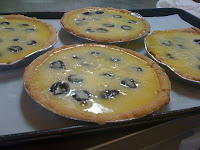But the biggest thing is sugar free baking, something I am just starting to explore, both in the bakery and at home.
Last night, after my last day, I started a new first. My first experimental recipe using xylitol instead of sugar. My boss, and bakery owner, is excited to also start experimenting with xylitol, and since I am the head (and only) baker, I get to do all the recipe development.
My first trial, using things I had on hand (since I didn't want to run out the the grocery store, again), ended up being a loaf of banana bread/cake. I adapted it from a recipe in the only known xylitol cookbook, Sweeten Your Life the Xylitol Way by Karen Edwards (available on amazon), for Banana Cake, baked it late last night, and tried the first slice this morning for breakfast. Not too bad for my first try! And it is definitely sweet.
I will share all my trial sugar free recipes, whether they use xylitol, stevia or no substitute. I doubt I will be experimenting with the harsher chemical sugar substitutes such as aspartame (Equal and NutraSweet), and try to stick with a natural approach.
Xylitol can be substituted for sugar, 1:1. It will not caramelize or feed yeast, but is otherwise a very useful and easy alternate. I have read that xylitol is very deadly to dogs, more so than chocolate, so be very careful to keep your stash and xylitol baked goods away from your K-9 pals!
Banana Loaf Cake
adapted from Sweeten Your Life the Xylitol Way by Karen Edwards
2/3 cup whole wheat flour
1/2 teaspoon baking soda
pinch of salt
1 tablespoon + 1 teaspoon butter, melted
1/2 cup mashed ripe banana (about one medium-large banana)
2 tablespoons + 2 teaspoons plain yogurt
1/2 teaspoon vanilla extract
1 egg, seperated
1/2 cup xylitol
- Combine flour, baking soda and salt in a bowl and set aside.
- In another bowl, mix together the melted butter, mashed banana, yogurt, vanilla and egg yolk.
- In a large bowl, beat the egg white with electric mixer until soft peaks form, then add the xylitol and beat until peaks are stiff but not dry.
- Gradually fold dry ingredients into beaten egg whites alternately with banana mixture, and stir just until batter is smooth.
- Pour into and spread evenly in a greased 8" x 4" loaf pan, and bake at 350 degrees F for 15-20 minutes, until a toothpick inserted in center comes out clean. Cool completely.
- Store at room temperature in an airtight container.

















